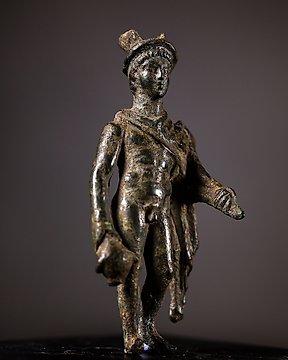
Römisches Reich Bronze GottMercury-Figur - 9 cm
Nr. 83804613

Nr. 83804613

Male Portrait
Ancient Roman, 1st century BC – 1st century AD
Marble
Height 32.4 cm
CONDITION: Good condition, without restorations.
PROVENANCE: - Private collection, England. Private collection, France, 1980s.
PUBLISHED: - Bonhams. Antiquities. 28th October 2009. Lot 223.
DESCRIPTION:
Realistically carved with mature features, the creased forehead with the brows drawn together in a frown, the face heavy and lined, the chin rounded with soft jowls, the hair short and brushed forward into a fringe.
Roman Republican portraiture was practiced during the period of the Roman Republic. Examples of Roman portraiture, both sculpture and painting, are more abundant for the Imperial period. Republican portraiture is characterized by verism influenced by Hellenistic portraiture, and survives mainly as marble and bronze sculpture. Roman portrait busts are thought to derive in part from death masks or funerary commemorations, as elite Romans displayed ancestral images (imagines) in the atrium of their home (domus).
Portraiture in Republican Rome was a way of establishing societal legitimacy and achieving status through one's family and background. Exploits wrought by one's ancestors earned them and their families public approbation, and more; a pompous state funeral paid for by the state. Wax masks would be cast from the family member while they were still living, which made for hyper-realistic visual representations of the individual literally lifted from their face. These masks would be kept in the houses of male descendants in memory of the ancestors once they had passed. These masks served as a sort of family track record, and could get the descendants positions and perks, similar to a child of two alumni attending their alma mater.
Republican Rome embraced imperfection in portraiture because, though there were different levels of power each class of society had, everybody had little insecurities, this type of untouched physical representation fostered a sense of community by implying that while there were existing inequalities, that did not change the fact that they were Romans.
Notes:
- The piece includes authenticity certificate.
- The piece includes Spanish Export License.
- The seller guarantees that he acquired this piece according to all national and international laws related to the ownership of cultural property. Provenance statement seen by Catawiki.
#masterpieces
So kaufen Sie auf Catawiki
1. Etwas Besonderes entdecken
2. Höchstgebot abgeben
3. Sichere Zahlung durchführen